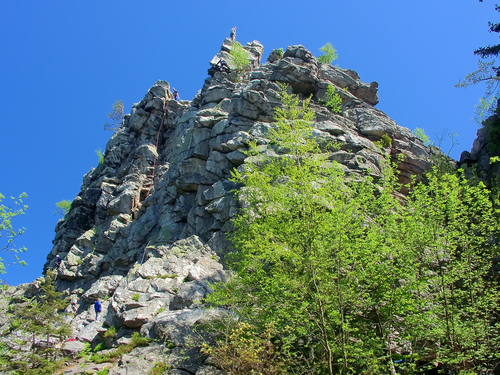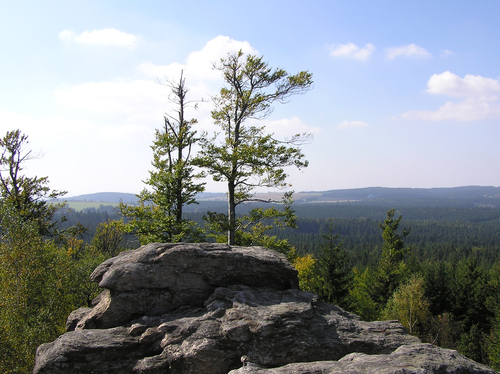Tours
Walking routes
- Gallery was established in 1997 by artists Janem Odvárkou, Rudolfem Němcem and Pavlem Mertlíkem.
- An art gallery dedicated to the artists of the Czech-Moravian Highlands.
- Buchtův" hill (813 meters above sea level) is located in the Protected Landscape Area "Žďárské" Hills.
- At of the top is the radiolocation tower with cupola on the roof in of altitude of 840 m, the highest fixed point connected to the ground in in "Žďarské" Hills.
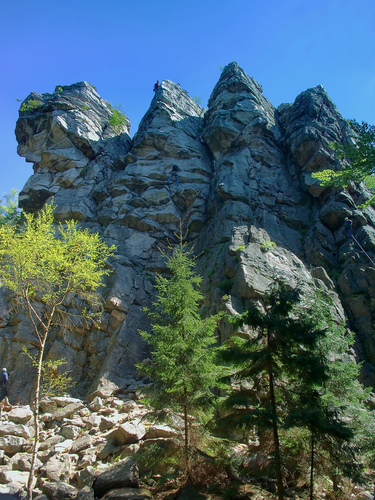
- Four rock towers (Four Hammers) are located in Zdar Peaks (Zdarske vrchy).
- This rock formation consists of three rock blocks (Děvín, Paličatá, Tvrz) and the Opomenutá rock ridge.
- Four Hammers is a rock formation having been modelled by the frost disintegrating and is surrounded by broken stones with a well-preserved wood in 732 metres above sea level. The tops of the rocks have the shapes of heads and are used as a training terrain for mountain climbers.
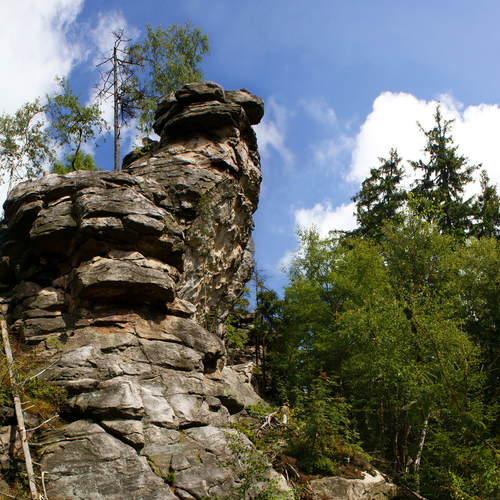
- The Czech-Moravian Highlands have a protected area called Žďárské Vrchy in which the Devět Skal (the Nine Rocks) is located.
- Devet Skal, which is a protected natural formation with limited mountaineering activity, is the highest peak in Zdar Peaks (Zdarske vrchy) with the range of peak rocks close to the Milovsky pond.
- This place is ideal for sports and relaxation.
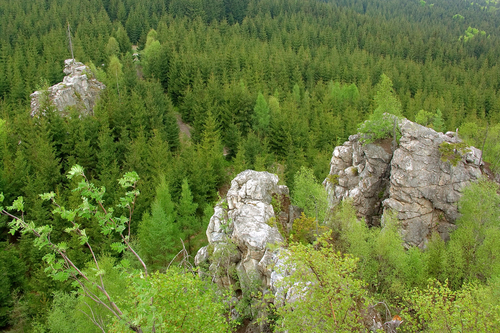
- High peak called Malinská skála is one of the best views in n Žďárské vrchy.
- If you go to Malinská skála from the east, you have three options – either along the green from the Milova pond, along the red from Blatiny, or from Sněžné, or along the forest road from Samotín. All these three paths will meet at the crossroads of Drátenička and from there you will continue along the red road.
- Source: https://www.gigaplaces.com/en/article-ascent-to-malinska-skala.
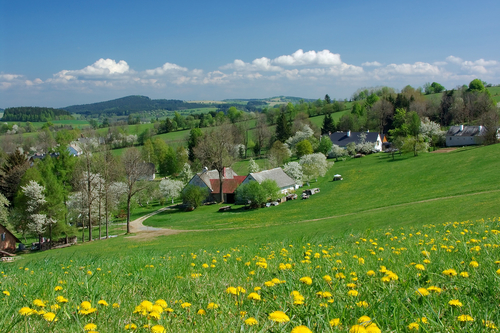
- Blatiny is a typical village of late mountain colonization with scattered buildings. Individual cottages were built in the middle of cultivated fields, meadows and pastures. Scattered cottages, many of which still have preserved folk architecture, are hidden under massive treetops and surrounded by spring blooming meadows.
- Blatiny is great place for cycling, horse riding and skiing.
- The settlement Milovy got its name from the local lands, as already in 1587, during the estimation of the New Town estate, meadows and a stream were listed here as "Milojovi".
- In 1850, Moravské Milovy was annexed to Sněžný (then Néměké) and has remained there to this day as a part of the village under the name of Milovy.
- Do you like mushroom hunting? Milovy is a perfect place for this hobby.
Day trips
- Zdar nad Sazavou is situated at the frontier of Bohemia and Moravia in a picturesque region of Bohemian-Moravian Highland in the centre of the protected landscape area of Zdarske vrchy.
- The city is both industrial and tourist centre. It is known for the Pilgrimage Church of Saint John of Nepomuk, which is a UNESCO World Heritage Site.
- The Church of St. John of Nepomuk on Zelená hora is one of the most original buildings in Europe. This UNESCO monument and work of the talented architect Jan Blažej Santini Aichel is aplace which deserves to be visited by all those who appreciate its mysticism and unique architecture, interwoven with the powerful story of St. John of Nepomuk, the Czech saint.
- People visit Nové Město na Moravě especially for sport. In winter, it is a mecca for Czech biathlon and cross-country skiing; in summer, the Mountain Bike World Cup takes place there. But the pretty town in the Vysočina region in the centre of the Czech Republic also has some landmarks.
- The historical centre of Nové Město is an urban preserve, the most important site being the Church of St. Cunigunde. Another patroness of the church is St. Anne and inside you will find a rare woodcut, saved from the devastating fire in 1723. At the Vratislav Square, there is also a château with the Horácká Gallery. The interesting old town hall building is the home to the Horácké Museum with an exposition on folk culture and skiing. House No. 13 commemorates the victims of Holocaust with the story of the Brada Jewish family.
- Source: https://www.visitczechrepublic.com/en-US/f84d5cc4-cbd2-48d7-9922-4a12d1404347/place/t-nove-mesto-na-morave
- A castle was was founded by the lords of Medlov (who subsequently called themselves Pernštejn) between 1270 and 1285.
- In the palace part visitors can trace the history and development of the building from a simple castle through to a Late Gothic fort, Renaissance palace, and then Baroque, Rococo and Neo-Classical residence, up to the Romanticism of the 19th century.
- Pernštejn, built with the use of white Nedvědice marble, ranks among the best preserved castles in the Czech.
About
- Jihlava is an ancient town in the heart of the Bohemian-Moravian Highlands, founded more than 800 years ago, boasts a long and colourful history.
- The Vysočina Region is renowned as “an island of health”, far from busy life of city centres; well-known for its hills and valleys, its wealth of woods and groves, streams and ponds. Here you will find dozens of protected landscapes, hundreds of protected areas and natural monuments. It is a perfect place for outdoor activities and recreation
- Three UNESCO World Heritage monuments are located within 30 km from Jihlava (the Historic Centre of Telč, the Jewish Quarter and St Procopius' Basilica in Třebíč and the Pilgrimage Church of St John of Nepomuk at Zelená Hora in Ždár nad Sázavou). Not only these are worth visiting in Vysočina, however. You will soon discover - as anywhere in the Czech Republic, rich in history and culture – an abundance of historic sights such as medieval castles, magnificent palaces, picturesque country houses and peaceful old town squares.
- Source: https://en.vspj.cz/practical-information/jihlava-and-vysocina-region
Jihlava Zoo
- There are more than 150 species of exotic animals. The zoo’s main attractions include the Matongo African Village and the large exhibition of sun bears with running water and rock gullies. You will be ensured an edifying walk thanks to a mobile application, which you can download from the zoo website free of charge. If you and your friends make up a group of at least ten, an expert will be made available to answer all of your questions. You can even get married here in an African, Mexican or Japanese style.
- Source: https://www.visitczechrepublic.com/en-US/Things-to-Do/Places/Nature/Zoos-and-Aquariums/c-jihlava-zoo
- The “Gateway to Heaven” or Porta Coeli in Latin is a unique convent complex near the quiet little town of Tišnov.
- As early as the 13th century, it was founded as a Cistercian monastery for women by Queen Constance. A community of Cistercian sisters still lives here today.
- There are guided tours through the Gothic core of the monastery every hour. You can see a church, a Chapter hall and a beautiful cloister with a garden of paradise, which will bring even non-believers into a state of contemplation. There are four permanent exhibitions and numerous seasonal exhibitions in the Podhorácké Museum located in the building of the former provost’s office.
Sports
- Nové Město na Moravě - http://www.skiharusak.cz/
- Hlinsko - http://www.hlinecko.cz/ski/
The White Highway - https://www.korunavysociny.cz/turisticke-cile/726-bila-magistrala
If the weather is good and there is enough snow, the surroundings of Sněžný offer a large number of cross-country skiing tracks.

